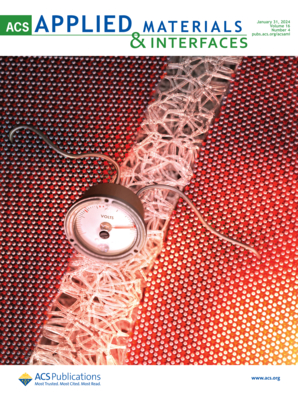Deciphering the Role of Inorganic Nanoparticles’ Surface Functionalization on Biohybrid Microbial Photoelectrodes
IF 8.3
2区 材料科学
Q1 MATERIALS SCIENCE, MULTIDISCIPLINARY
引用次数: 0
Abstract
Shedding light on the interaction between inorganic nanoparticles (NPs) and living microorganisms is at the basis of the development of biohybrid technologies with improved performance. Au NPs have been shown to be able to improve the extracellular electron transfer (EET) in intact bacterial cells interfaced with an electrode; however, detailed information on the role of NP-surface properties in their interaction with bacterial membranes is still lacking. Herein, we unveil how the surface functionalization of Au NPs influences their interaction with photosynthetic bacteria, focusing on cell morphology, growth kinetics, NPs localization, and electrocatalytic performance. We show that functionalization of Au NPs with cysteine in the zwitterionic form results in a uniform NPs distribution in purple bacteria, specifically locating the NPs within the outer-membrane/periplasmic space of bacterial cells. These biohybrid cells, when coupled with an electrode, exhibit enhanced EET and increased (photo)current generation, paving the way for the future development of rationally designed biohybrid electrochemical systems.

解密无机纳米粒子表面功能化对生物杂交微生物光电极的作用
揭示无机纳米粒子(NPs)与活体微生物之间的相互作用是开发性能更佳的生物混合技术的基础。金纳米粒子已被证明能够改善与电极连接的完整细菌细胞的胞外电子传递(EET);然而,有关纳米粒子表面特性在其与细菌膜相互作用中的作用的详细信息仍然缺乏。在此,我们揭示了金氧化物表面功能化如何影响其与光合细菌的相互作用,重点关注细胞形态、生长动力学、金氧化物定位和电催化性能。我们的研究表明,用半胱氨酸对齐聚物形式的 Au NPs 进行功能化可使 NPs 在紫色细菌中均匀分布,特别是将 NPs 定位在细菌细胞的外膜/质膜空间内。这些生物杂交细胞与电极结合后,显示出更强的 EET 和更高的(光)电流生成,为未来开发合理设计的生物杂交电化学系统铺平了道路。
本文章由计算机程序翻译,如有差异,请以英文原文为准。
求助全文
约1分钟内获得全文
求助全文
来源期刊

ACS Applied Materials & Interfaces
工程技术-材料科学:综合
CiteScore
16.00
自引率
6.30%
发文量
4978
审稿时长
1.8 months
期刊介绍:
ACS Applied Materials & Interfaces is a leading interdisciplinary journal that brings together chemists, engineers, physicists, and biologists to explore the development and utilization of newly-discovered materials and interfacial processes for specific applications. Our journal has experienced remarkable growth since its establishment in 2009, both in terms of the number of articles published and the impact of the research showcased. We are proud to foster a truly global community, with the majority of published articles originating from outside the United States, reflecting the rapid growth of applied research worldwide.
 求助内容:
求助内容: 应助结果提醒方式:
应助结果提醒方式:


